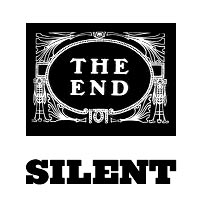 |
Part 1 |
Silents are the films of the
early era that were without synchronized sound, from the
earliest film (around 1891), until 1927, when the first 'talkie', The
Jazz Singer (1927) - the first commercially successful
sound film, was produced. Its follow-up was The Lights of New
York (1928), the first all-synchronized-sound feature. The silent
era basically lasted until the end of the decade when most films
were all-talkie, although there were hold-outs like Chaplin's Calling them silent films was something of a misnomer. In the earliest silent film days, movies were often accompanied by a phonograph recording. Then, movie theatres and other dream palaces provided live music from pianists, organists, wurlitzers, and other sound machines. In the larger cities with bigger theaters, silents were usually accompanied with a full-fledged orchestra to provide musical background and to underscore the narrative on the screen. Live actors, singers or narrators were sometimes provided, and some films were produced with complete musical scores (but many organists and pianists just improvised). Unfortunately, many of the early classics have been lost to decomposing nitrate film bases and outright destruction. Estimates by some film historians state that about 80% of silents have been lost forever. Silent films, usually made with low budgets and few resources, were an important evolutionary stage in the development of movies, since they forced film-makers to tell engaging narrative stories with actors who could emote (with body language and facial expressions). They provided the major foundational elements and visual vocabulary of cinema, including mise en scene, lighting, cinematography, set design, costuming, camera shots, composition, movement, special effects (jump cuts, dissolves, superimpositions, miniatures, matte paintings), and more. After the film was shot, editors were compelled to use fundamental techniques (montage, cross-cutting, parallel scenes, tableaux, etc.) to convey the proper rhythm and continuity. (See Filmsite's Film Terms Glossary) Early masters of cinema during the silent years
included Cecil B. De Mille, known for his epics such as The
Ten Commandments (1923), Erich Von
Stroheim's dramatic tale of the degenerative effects of avarice in Early pioneering director D. W. Griffith was often identified with silent epics including:
The most-remembered films from the silent years are the visual
comedies from the Mack Sennett Keystone Kops series, starring Fatty Arbuckle
and Mabel Normand, and slapstick from the 'silent clowns.' Tragi-comic superstar
Charlie Chaplin is most noted for The Kid (1921), his classics including Physically-daring comedian Buster Keaton ("Old
or Great Stoneface")
appeared in many other classic comedies, including Sherlock
Jr. (1924), In the modern era, only a few films have been made as silents - some as homage to the period, including Jacques Tati's Les Vacances de Monsieur Hulot (1953, Fr.) (aka Monsieur Hulot's Holiday), Mel Brooks' Silent Movie (1976), Charles Lane's Sidewalk Stories (1989), Eric Bruno Borgman's The Deserter (2003), and the Best Picture-winning mostly-silent The Artist (2011). |